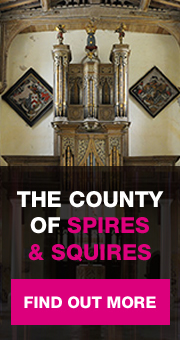One of the most rewarding of the county’s churches to visit all be it that it is best to arrive accompanied by a passenger otherwise you have to deal with the gated road from the village on your own!. The church stands remote amongst fields, adjacent to a charming early 18th century Manor House. The village itself was moved to it’s present site almost a mile away, with the influx of sheep in the late 15th century. The church dates back to at least the 13th century and has been particularly fortunate in the quality of later alterations. In the 16th century for instance came the construction of a series of fine memorials to the Andrews family including a splendid tomb by Thomas Parker of Burton on Trent. This was followed by a Jacobean pulpit, Queen Anne communion rails etc. Perhaps the most surprising change though came through the rebuilding of the chancel between 1901 and 1904 which introduced the Arts and Crafts movement to this remote village. William Douglas Caroe (1857-1938), one of the most important arts and crafts architects undertook this work in 1904. He is probably best remembered for his restoration of Durham Cathedral and Tewkesbury and Romney Abbeys. He and Eric Gill were commissioned by Father O'Brien the rector here. Externally it is expressed in the decorative scroll work on the lead guttering and the carved reliefs around the east windows. The altar furnishings of the same period – very distinctive. The east end lettering is by Eric Gill. ( the pews though which might be thought to be part of this re ordering as they replace the Georgian box ones are not. They were originally designed by G F Bodley for Elmscott Lawn Church ( Leamington ) and were brought here in 1973. Do make a pilgrimage here, you will not be disappointed.
Please refer to the Glossary for any terms in the text that you are unfamiliar with.







